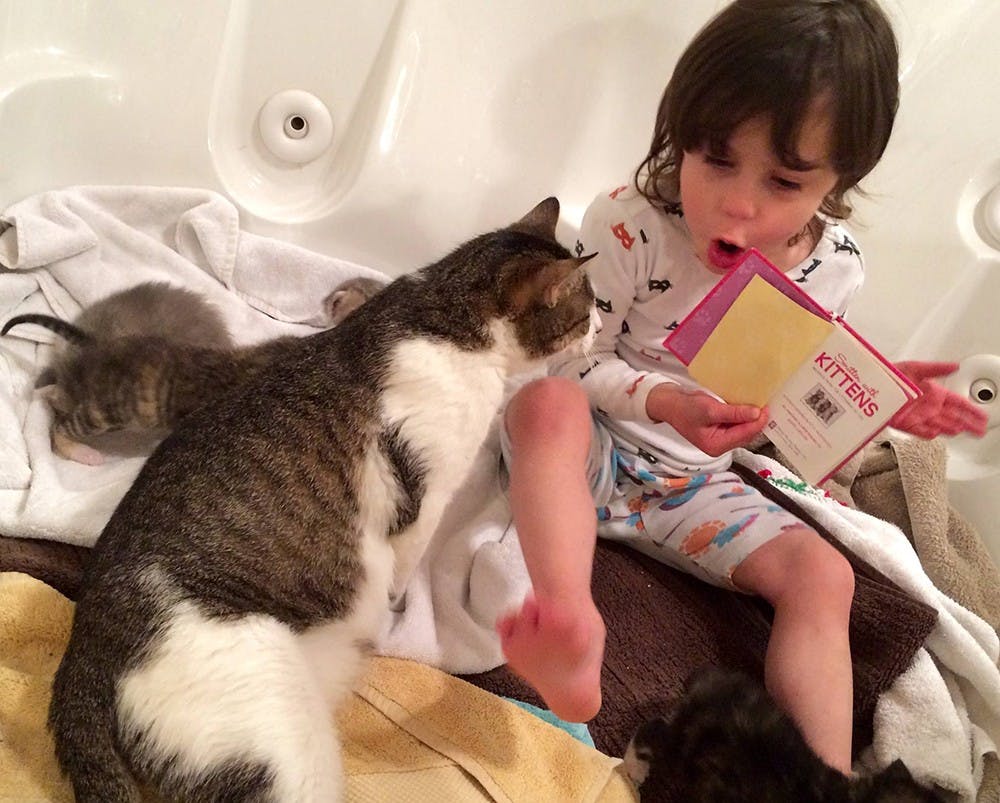The question was necessary for the IU journalism professor who recieved a litter of kittens, not yet old enough to fend for themselves, which had prompted her to create a temporary bed in a classroom file cabinet.
“I put them in the bottom drawer with a litter box and a heating pad,” Benham French said.
Tiny animals have made appearances in Benham French’s classes ever since.
As a participant of the Bloomington Animal Shelter’s foster program, Benham French lives with three adopted housepets — two cats, one dog — and a rotating cast of shelter animals who stay for as long as they need before they can move into a good home.
Benham French said she understands many of her students miss their pets at home, and fostering is a good way to fill that hole in their life until the students have moved into a permanent location.
Benham French began fostering animals at college in Gainsville, Florida.
“It just sounded too good to be true — it was like a library of pets,” Benham French said. “It was just an ideal situation for a college student.”
Benham French went from fostering single dogs to taking in litters of puppies, including a group of seven hounds who contracted parvovirus, an infectious disease with a high mortality rate in puppies.
Benham French dropped classes to care for the puppies and lost one — an experience she said reaffirmed her desire to care for “more fragile animals (like) the sick ones and the mothers.”
Her daughter Juniper’s first experience with fostering animals was with a pregnant cat, Monkey.
Benham French said fostering helps teach children about empathy and responsibility.
Now Juniper helps feed and care for the little critters.
“She just understands that we’re helping them get new families,” Benham French said. “She kisses them goodbye, pets them in their cage.”
Benham French has even delivered litters in her shower.
When she worked at the St. Petersburg Times, a German shepard she fostered dropped 14 puppies abruptly in her front lawn.
Given her own dogs and other foster situations, the glut of babies meant Benham French had 20 dogs in her house for a couple of days.
“When the first one’s born, you’re like, ‘This is amazing, it’s so beautiful!’” Benham French said. “By the 10th, you’re just throwing them on the pile, like, ‘How many are there?’”
When people dump litters of puppies at shelters, Benham French said, they test the organization’s resources as well as the fragile young dogs’ immune systems in an environment with so many other animals.
Benham French said Bloomington’s animal shelter is one of the best she’s worked with. She said other places might have a one-to-one ratio of litters they can keep versus ones they have to put down.
After another young animal died from an infection, Benham French said she was again shown the need for foster programs.
“I was so upset,” she said. ” I called the director and said, ‘I can’t do this anymore.’”
The director asked Benham French to come to the Alachua animal shelter to talk, she said.
“She took me to the shelter and it was like, ‘Here are four litters of puppies — we can save one if you take it home,’” Benham French said.
Bloomington Animal Care and Control director Virgil Sauder called fostering animals “the most dramatic life-saving activity.”
“We do know that the longer a young kitten or puppy is at the shelter, the more likely it is to get sick — perhaps fatally so,” Sauder said. “If the only option we had was the shelter, we’d fail miserably.”
Volunteering with animals may bring up ideas of walking dogs or grooming cats, but foster programs may change that, Sauder said.
Foster animals can be removed from the shelter for several reasons: medical issues like worms, neonatal litters of puppies or kittens that are too young to be legally adopted or not “showing” well — having a behavioral problem that makes families hesitant to take the animal on.
Foster placements can also reveal aspects of animals’ personalities — good and bad — that may not have manifested in the shelter, said Julia Eppley, shelter manager and foster program coordinator.
For example, a dog may become aggressive around crowds, but the shelter would only realize this once the dog has been in a home environment.
“We get a lot of the eight-month-old to a year-and-a-half (dogs) who weren’t trained well as puppies,” Sauder said.
These animals may act too unruly in the shelters or be shy or even aggressive around other animals, which can mean a larger time and energy commitment to potential adopters.
Barb Sholtis, another foster program member trains dogs to show well to adoptees.
“I do it primarily to help those dogs who don’t get looked at for various reasons, to try to make them more adoptable,” Sholtis said.
In a shelter environment, not all animals will show to their best advantage, Sholtis said.
Lots of times people turn in animals with too much energy for them to comfortably handle, Sholtis said. In those cases, performance or other training activities might be an outlet.
“Even if you don’t want a performance dog, you want to bond (with them),” Sholtis said.
She stressed patience and consistent expectations for the foster dogs’ training — essential traits for potential foster parents to keep in mind.
“To be a foster parent, you don’t have to know (everything),” Sholtis said. “Everyone can learn if someone tells them — people shouldn’t be intimidated.”
“I enjoy dogs,” Sholtis said.” I love dogs and want them to find their forever homes. It’s hard to give (them) up, but you’re changing (their) lives for the better.”
During her walks, Sholtis takes the animals downtown, on campus and through parks — anything to expose them to real-world environments.
She also keeps treats in her pockets to offer passers-by, in case they’d like to feed the dog and help build its trust.
Her toughest foster from Bloomington was a dog who didn’t know how to walk — or move, even — on a leash, Sholtis said.
After spending the entire first 24 hours in his crate and requiring a sling to move outside, Sholtis said she helped the dog to walk with confidence and his tail upright.
“That’s an example of a dog someone would’ve looked at and gone, ‘No way,’” Sholtis said. “But he did well.”
After years of experience, Sholtis said she still has things to learn from her foster pets.
“I think I get as much out of it as they do,” Sholtis said. “Every one teaches me something.”






